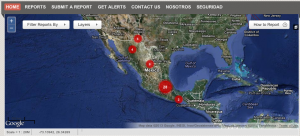LatinaLista — While the number of how many Mexican journalists who have been assassinated by drug cartels isn’t exactly known — the number ranges from 70 upwards — one thing is certain — Mexican journalists have become prime targets for cartel violence. It has gotten so bad that aside from several journalists fleeing the country and petitioning for asylum in the United States and other countries, the Mexican Congress was forced to create constitutional measures to safeguard Mexican journalists.

CPJ commends new Mexican legislation
New York, April 25, 2013-The Committee to Protect Journalists welcomes the approval today of legislation that will implement a constitutional amendment that gives federal authorities in Mexico broader jurisdiction to prosecute crimes against freedom of expression.“This is a legislative milestone and a step forward in the fight against the impunity that persists in crimes against the press,” said CPJ senior Americas program coordinator, Carlos Lauría. “We urge President Enrique Peña Nieto to immediately sign these measures into law and then ensure that authorities effectively use this new tool to bring the killers of journalists to justice.”
The legislation passed today will implement a constitutional amendment passed by the Mexican federal congress in 2012. The legislation establishes accountability at senior levels of the national government, evading the more corrupt and less effective state law enforcement officials. CPJ research shows that more than 50 journalists have been killed or disappeared in Mexico in the last six years.
Yet, Mexican journalists aren’t waiting around for the new president to sign the measure. Over the weekend, they held marches in over 20 cities throughout Mexico. As one Mexican journalist shared, the day was especially important because for the first time, Mexican journalists represented themselves, and left behind official organizations that represent journalists. In many towns, the journalists overcame their fear to go out in the streets and risk losing their jobs.
“We discovered the collective voice of journalists that we didn’t know existed, in zones we thought were lost. Because from everywhere, the message was the same, in one voice.”
However, regardless of the new constitutional amendment and the renewed effort to band together, Mexican journalists remain targets of the cartel. Because many newspapers have been shot at or bombed or their reporters murdered, newspapers across the country have decided the best way to preserve their businesses and the lives of their employees is to look the other way when cartel crime is committed in their cities. Too often that also includes the murders of their own journalists or bloggers who are fighting the violence overtaking their society.
To provide a safe way to let the world know about attacks on Mexican journalists and its toll on freedom of expression in Mexico, a new digital tool was launched last week called “Periodistas en Riesgo” (“Journalists at Risk”).
Sponsored by the Freedom House and the International Center for Journalists (ICFJ), the map is the brainchild of Jorge Luis Sierra, a Knight International Journalism Fellow who created the map as part of his fellowship. Sierra has a background in developing digital tools that track crime and corruption but claims Periodistas en Riesgo is “Latin America’s first digital crowdsourcing platform related to freedom of expression.”
The map records incidents that have occurred since December 1, 2012, which marked the beginning of a new federal administration in Mexico. Already, the results are chilling. As of April 22, the map had already recorded 41 cases of assault on journalists and bloggers. The incidents include: two murders; one disappearance; five attacks with explosives and shootings of media offices; and three kidnappings. There were also incidents of verbal attack; theft; destruction of equipment; legal harassment; and theft of electronic files.
The map also shows information on severe cases of attacks on journalists from 2005 to 2012.
The reports to be mapped depend on anonymous tipsters, whether they be the public or journalists. Safeguards have been built in to the reporting of attacks so no one receives retaliation from the cartels, corrupt government and law enforcement officials or intimidated employers.
While no one believes attacks on Mexican journalists will end anytime soon, the hope is that with greater awareness of what is happening to journalists and the digital tools to empower both the public and the media to keep reporting about senseless attacks on the innocent, freedom of expression can be preserved during a time that has cost too many good people their lives.




